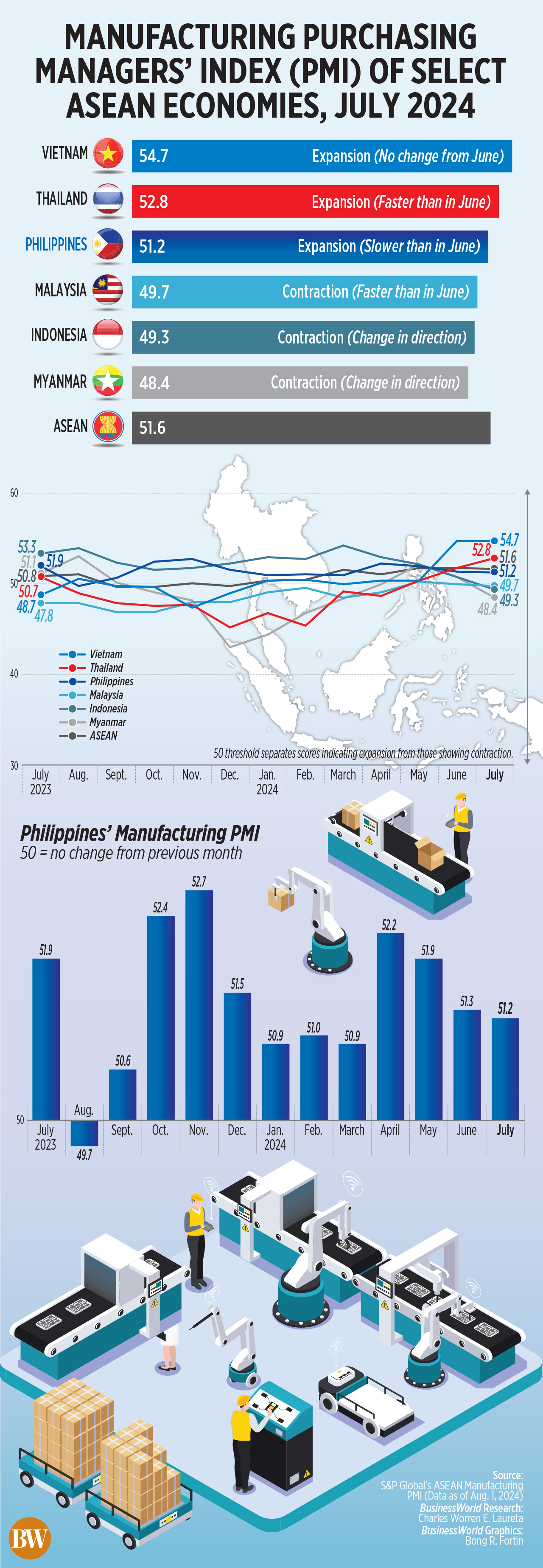MANUFACTURING GROWTH slowed slightly in July amid weaker expansion in production and orders, S&P Global said on Thursday.
The S&P Global Philippines Manufacturing Purchasing Managers’ Index (PMI) stood at 51.2 in July, easing from 51.3 in June.
“The latest index reading signaled only a modest improvement in the health of the Filipino manufacturing sector, and one that was the weakest since March (when PMI stood at 50.9 reading),” it said.
 July also marked the 11th straight month of improvement in operating conditions. A PMI reading above 50 signals improvement in operating conditions, while a reading below 50 means the opposite.
July also marked the 11th straight month of improvement in operating conditions. A PMI reading above 50 signals improvement in operating conditions, while a reading below 50 means the opposite.
Among Association of Southeast Asian Nations (ASEAN) member countries with available data, the Philippines had the third-highest reading in July after Vietnam (54.7) and Thailand (52.8). Malaysia (49.7), Indonesia (49.3), and Myanmar (48.4) all recorded contractions.
Philippine PMI was also lower than the ASEAN average of 51.6 in July.
“The second half of the year started modestly, with the Filipino manufacturing sector signaling further upticks in output and new orders,” Maryam Baluch, an economist at S&P Global Market Intelligence, said in a report.
“Though in both cases, the rates of increase were weaker than their respective long-run averages, thereby indicating relatively subdued growth across the sector.”
S&P Global said the latest data showed production activity grew at the slowest pace in the last four months due to longer supplier delivery times.
“The incidence of delay was the most pronounced since February as port congestion hampered the timely delivery of inputs,” it said.
On the other hand, demand improved in the Philippine manufacturing sector.
“New orders rose at a rate faster than June’s five-month low. However, firms recorded modest and cooling demand from overseas markets,” S&P Global said.
Despite this, a sustained increase in production requirements allowed manufacturers to boost purchasing activity in July.
“Though the rate of growth softened since the preceding survey period, it was solid overall. Firms remained keen to expand their holdings of finished goods and purchased items. Both pre-and post-production inventories were accumulated at rates stronger than their respective long-run averages,” S&P Global said.
Even though the backlog fell for the 13th month in a row, manufacturing firms raised staffing levels in July after seeing a “strong uptick” in new orders. S&P said this was the first increase in employment since April, although it was still “modest overall.”
It said the July data showed costs slightly increased in July even though the rate of input price inflation went up to a five-month high. On the other hand, the pace of the rise in charges slipped to a three-month low.
The effects of Super Typhoon Carina had likely caused disruptions in manufacturing and other business activities in Metro Manila and nearby provinces, said Rizal Commercial Banking Corp. Chief Economist Michael L. Ricafort.
Last week, Metro Manila and nearby provinces experienced torrential rains and heavy flooding brought by Carina (international name: Gaemi) and the southwest monsoon.
OUTLOOK
Meanwhile, Ms. Baluch said easing inflation, as seen in the PMI data, could allow the Philippine central bank to begin cutting rates.
“Easing financial conditions should help solidify and strengthen growth in the coming months,” she noted.
“Moreover, sustained expansions in purchasing activity and the renewed uptick in workforce numbers, indicate that goods producers are likely banking on the strengthening of demand conditions in the coming months.”
The Monetary Board has kept its key policy rate at an over 17-year high of 6.5% to tame inflation. Bangko Sentral ng Pilipinas Governor Eli M. Remolona, Jr. signaled a possible rate cut at their Aug. 15 meeting.
Mr. Ricafort said the slower PMI growth “could help support/justify” a 25-basis-point rate cut as early as next week.
S&P Global said manufacturing firms expect production to increase in the next 12 months.
“The Future Output Index, which printed comfortably above the neutral 50 mark in July, indicated optimism regarding the outlook across the sector,” it said.
However, there was a slight dip in the degree of confidence as some firms remained cautious of future demand.
Security Bank Corp. Chief Economist Robert Dan J. Roces noted that manufacturing firms’ cautious optimism is reflected by their hiring activity and inventory accumulation.
“While risks such as global economic conditions and supply chain disruptions persist, the overall outlook for Philippine manufacturing remains positive, with growth expected to continue, albeit at a modest pace, in the coming months,” he said in a Viber message.
Mr. Ricafort said there is a seasonal increase in imports and production in the third quarter in preparation for higher demand in the fourth quarter.
“This would help boost manufacturing/production growth in the coming months,” he said, although business activity might slow during the “ghost month” of August. — Beatriz Marie D. Cruz

